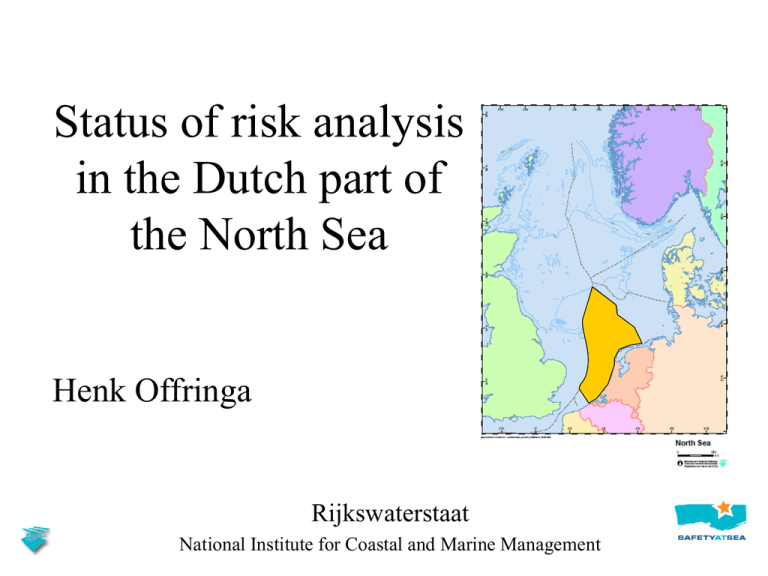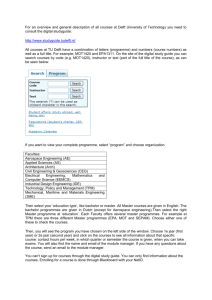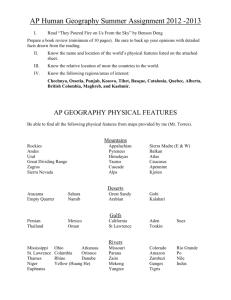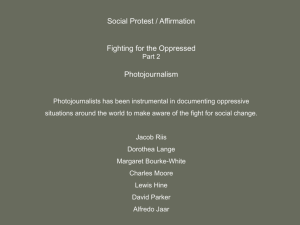Status of risk analysis in the Dutch part of the North Sea
advertisement

Status of risk analysis in the Dutch part of the North Sea Henk Offringa Rijkswaterstaat National Institute for Coastal and Marine Management Note ‘To protect vulnerable marine and estuarine areas’ ‘Capacity note 2006 – 2010’ (issued 2006) Indicates the extent of resources needed to combat pollution due to calamities at sea Based on risk analysis Risk analyses Pollution sources Risk = chance * effect Prevention Required resources for incidents Sources of pollution •• Incidental from:installations, shipping, under Shipping discharges >>>>> offshore offshore installations, under water pipelines, water pipelines, harbour activities, aeroplane harbour activities, aeroplaneonaccidents accidents and installations shore; and installations on shore; • Crude oil >>>>> Heavy Fuel Oil (HFO) and chemical substances Top 10 of crude oils unloaded in Rotterdam Name Origin Volume (Mton) 2000 Arabian Light Saudi Arabia 9,22 4,41 Russian Export Blend Russia 6,59 11,45 Oseberg Norway 5,87 3,1 Kuwait Export Kuwait 5,33 1,32 Kirkük Iraq 4,23 Gullfaks Norway 3,80 1,58 Forties Great Britain 3,70 1,4 Arabian Extra Light Saudi Arabia 2,84 0,9 Arabian Medium Saudi Arabia 2,67 Alba Great Britain 2,25 Σ ~ 100 Mton 2004 Risk = chance effect Traffic density, routes and transport of substances Risk on incidents ~ frequency and nature Risk on spills ~ frequency and nature Human health Logistic and practical aspects Economical valuable objects and areas Ecological vulnerability finances Transport routes, approach Cargo data Lloyds database Port A Arrival date IMO-number Type of oil Amount of oil Type of activity Arrival port A Arrival date Previous/next port (B) IMO-number Ship type/size Example: result Rotterdam (crude) • Almost all import • Main origin: – 40% Dover strait – 30% Northern part of the North Sea – 24% Baltic Amount of crude oil to Rotterdam <500 kton 500 – 1000 kton 1000 – 2500 kton 2500 – 5000 kton 5000 – 7500 kton 7500 – 10000 kton > 10000 kton Amount of HFO to Rotterdam <50 kton 50 – 100 kton 100 – 250 kton 250 – 500 kton 500 – 750 kton 750 – 1000 kton > 1000 kton Estimated passing ships with dangerous goods Conclusion transport • Quality is reasonable acceptable, but little is known on the exact routes • Passing ships is not discernible with this method • Preliminary: shift in transport routes through Baltic Further work: chance on collision and spills • Created traffic databases are used within the SAMSON-model (Safety Assessment Model for Shipping and Offshore on the North Sea). Samson is run by MARIN • Determine the frequency of an oil spill and the expected size of the oil spill. • Report 2004, data 2000, update not available yet Potential number of collisions between ships (regardless their cargo, year 2000) Aanvaringen tussen schepen (niet-routegebonden en/of routegebonden verkeer) ongeacht de lading. 56.0 minder dan eens in de 1000 jaar 100 en 1000 jaar 55.5 50 en 100 jaar 10 en 50 jaar 5 en 10 jaar 55.0 vaker dan eens in de 5 jaar kustlijn VSS 54.5 NEEZ 54.0 53.5 53.0 52.5 52.0 51.5 51.0 1.0 2.0 3.0 4.0 5.0 6.0 7.0 8.0 9.0 Reported collisions 2000-2003 Potential frequency of an oil spill as a result of any accident at sea (year 2000) Eens in de ... jaar een uitstroom van ladingolie (olieklasse 1 t/m 7) als gevolg van een ongeval op zee (alle type ongevallen) 56.0 meer dan 5000 jaar tussen 1000 en 5000 jaar tussen 500 en 1000 jaar tussen 250 en 500 jaar tussen 100 en 250 jaar minder dan 100 jaar kustlijn NEEZ VSS 55.5 55.0 54.5 54.0 53.5 53.0 52.5 52.0 51.5 51.0 1.0 2.0 3.0 4.0 5.0 6.0 7.0 8.0 9.0 Maximum amount of spilled oil that is expected to occur at least once every 10,000 year (based on traffic data year 2000) Finally: ecological vulnerability maps Doggersbank 49 Centrale Oestergronden (-40-50 NAP) 50 Klaverbank 55 Friese front 60 81 81 Rest NCP 82 Waddenzee 33 Kustzone 81 65 Kust 56 Belangrijke ecologische gebieden 81 81 Voordelta 65 81 83 Oosterschelde 67 Westerschelde Ecological advice in operational contingency planning dimension time advice 1 minute Immediate ½ hour Look up 1 hour Discuss with colleagues 3 hours Call external experts 3 days 3 weeks/months Monitoring / evaluation Method Acidification/basification Vulnerability class Reduced transperancy Substance Vulnerability Index (SVI) Oxygen depletion Bio Accumulation Toxicity Species Recoverability Index (SpecRI) Heating 10 91 1 105 5 35 5 35 1 35 5 31 5 95 1 3 510 31 5 3 10 3105 3 5 3 5 3 5 9 10 10 10 10 10 10 10 Status 10 Trend of population FE 39 FE 59 FE 44 FE 60 FE 76 FE 24 FE 30 FE 16 FE 24 FE 16 63 FE 44 63 20 61 Recruitment Smouthering/Constipation of cavities Mobility mT/year max class 11,451 heavy crude oil 3 4,419 5 light 4 5crude 4 oil 5 10 3 3,108 5 medium 6 2 10 5 oil 10 crude 7 1,986 5 10 0 1crude 0 oil 0 medium 7 1,669 5 10 0 6crude 0 oil 0 medium 10 1,58 5 10 0 8crude 0 oil 0 medium 2 1,466 5 light 6 0crude 1 oil 0 0 4 1,324 5 medium 6 0 1crude 0 oil 0 2 943 5 medium 2 0 0crude 0 oil 0 2 935 5 light 6 0crude 1 oil 0 0 2 5 2 0 0 0 0 10 5 10 0 4 fill0 in:0 7 5 10 0 1 0 0 10 5 10 0 4 0 0 2 5 6 0 0 0 0 3 5 6 5 10 5 10 Sensitivity Index (SI) behaviour Acidification/basification Oxygen depletion Reduced transperancy Heating Bio Accumulation Toxiciticy examples: R.E.B.C.O Allis shad Arabian light MP 1 Anglerfish Oseberg MB 1 Arctic skua Arabian heavy BF 6 Arctic tern Foroozan BN 7 auks 9 Gullfaks BS Avocet 2 Forties BC Bank vole Kuwait export RS 5 Barnacle goose BC light 2 Arabian extra Bar-tailed godwit 2 Asgård BC Bewick's swan BC 2 Black throated diver BN 7 Black-headed gull BN 7 Blacknecked grebe BN 7 Black-tailed godwit BC 2 Blue whiting MP 1 Smouthering/Constipation of cavities substance Exposure factor (EF) Habitat of the species effect English species name Species Recovery Points Stress Factors Substance (SpecRP) per recovery Species Sensitivity Points (SpecSP) per stress mechanism and per species) 0 2 10 1 5 3 28 0 low 1 10 16 01 0,011 0 low 1 50,011 22 42 50 0 1 50,051 moderate 22 82 52 0 1 50,081 moderate 2 52 26 10 65 0high 1 50,101 2 26 10 0,011 0 low 1 10 14 41 42 0 low 1 50,031 24 62 45 0 low 1 50,001 very 2 82 26 10 0,011 very 0 low 1 10 16 81 58 4 8 72 0,00 very low 0,091 moderate 0 2 10 56 63 52 4 8 55 0,06 moderate 8 4 48 0,09 moderate 2 2 32 0,01 low 6 8 85 0,01 very low Substance Vulnerability Index Acidification/basification Vulnerability class Reduced transperancy Substance Vulnerability Index (SVI) Oxygen depletion Bio Accumulation Toxicity Species Recoverability Index (SpecRI) Heating 10 91 1 105 5 35 5 35 1 35 5 31 5 95 1 3 510 31 5 3 10 3105 3 5 3 5 3 5 9 10 10 10 10 10 10 10 Status 10 Trend of population FE 39 FE 59 FE 44 FE 60 FE 76 FE 24 FE 30 FE 16 FE 24 FE 16 63 FE 44 63 20 61 Recruitment Smouthering/Constipation of cavities Mobility mT/year max class 11,451 heavy crude oil 3 4,419 5 light 4 5crude 4 oil 5 10 3 3,108 5 medium 6 2 10 5 oil 10 crude 7 1,986 5 10 0 1crude 0 oil 0 medium 7 1,669 5 10 0 6crude 0 oil 0 medium 10 1,58 5 10 0 8crude 0 oil 0 medium 2 1,466 5 light 6 0crude 1 oil 0 0 4 1,324 5 medium 6 0 1crude 0 oil 0 2 943 5 medium 2 0 0crude 0 oil 0 2 935 5 light 6 0crude 1 oil 0 0 2 5 2 0 0 0 0 10 5 10 0 4 fill0 in:0 7 5 10 0 1 0 0 10 5 10 0 4 0 0 2 5 6 0 0 0 0 3 5 6 5 10 5 10 Sensitivity Index (SI) behaviour Acidification/basification Oxygen depletion Reduced transperancy Heating Bio Accumulation Toxiciticy examples: R.E.B.C.O Allis shad Arabian light MP 1 Anglerfish Oseberg MB 1 Arctic skua Arabian heavy BF 6 Arctic tern Foroozan BN 7 auks 9 Gullfaks BS Avocet 2 Forties BC Bank vole Kuwait export RS 5 Barnacle goose BC light 2 Arabian extra Bar-tailed godwit 2 Asgård BC Bewick's swan BC 2 Black throated diver BN 7 Black-headed gull BN 7 Blacknecked grebe BN 7 Black-tailed godwit BC 2 Blue whiting MP 1 Smouthering/Constipation of cavities substance Exposure factor (EF) Habitat of the species effect English species name Species Recovery Points Stress Factors Substance (SpecRP) per recovery Species Sensitivity Points (SpecSP) per stress mechanism and per species) 0 2 10 1 5 3 28 0 low 1 10 16 01 0,011 0 low 1 50,011 22 42 50 0 1 50,051 moderate 22 82 52 0 1 50,081 moderate 2 52 26 10 65 0high 1 50,101 2 26 10 0,011 0 low 1 10 14 41 42 0 low 1 50,031 24 62 45 0 low 1 50,001 very 2 82 26 10 0,011 very 0 low 1 10 16 81 58 4 8 72 0,00 very low 0,091 moderate 0 2 10 56 63 52 4 8 55 0,06 moderate 8 4 48 0,09 moderate 2 2 32 0,01 low 6 8 85 0,01 very low Scenario: medium crude oil (example) Based on 34 species Dilemma’s • Do we need more sophisticated and detailed maps? • How do we value species in and outside SPA’s and SACs • Do we need harmonisation of existing maps? Thank you





